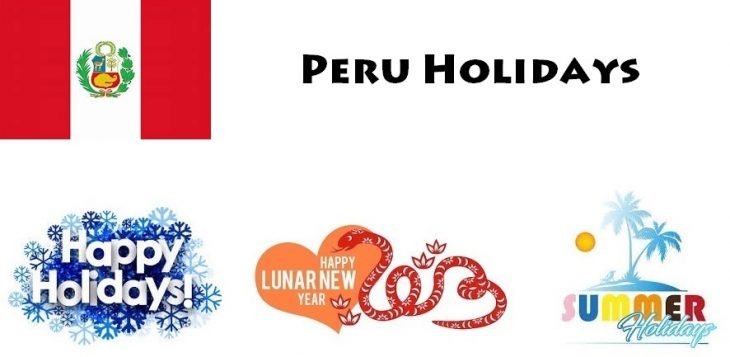Peru Holidays
Peru Public Holidays
Searching for the national holidays in Peru? All public holidays in Peru are treated like Sundays. This means that most of the Peru employees have a day off and all schools are closed on these office holidays. If you are planning a trip to Peru and want to know what the national and regional holidays are, check the details in the tables below.
List of Official Holidays in Peru for Year 2020
| # | Date | Holiday | Day |
| 1 | January 01, 2020 | New Year’s Day | Wednesday |
| 2 | April 09, 2020 | Maundy Thursday | Thursday |
| 3 | April 10, 2020 | Good Friday | Friday |
| 4 | May 01, 2020 | Labour Day | Friday |
| 5 | June 29, 2020 | Saint Peter and Saint Paul | Monday |
| 6 | July 27, 2020 | Independence Day Holiday (Bridge Day) | Monday |
| 7 | July 28, 2020 | Independence Day | Tuesday |
| 8 | July 29, 2020 | Independence Day Holiday | Wednesday |
| 9 | August 30, 2020 | Santa Rosa de Lima | Sunday |
| 10 | October 08, 2020 | Battle of Angamos | Thursday |
| 11 | November 01, 2020 | All Saints’ Day | Sunday |
| 12 | December 08, 2020 | Immaculate Conception Day | Tuesday |
| 13 | December 25, 2020 | Christmas Day | Friday |
List of Official Holidays in Peru for Year 2021
| # | Date | Holiday | Day |
| 1 | January 01, 2021 | New Year’s Day | Friday |
| 2 | April 01, 2021 | Maundy Thursday | Thursday |
| 3 | April 02, 2021 | Good Friday | Friday |
| 4 | May 01, 2021 | Labour Day | Saturday |
| 5 | June 29, 2021 | Saint Peter and Saint Paul | Tuesday |
| 6 | July 28, 2021 | Independence Day | Wednesday |
| 7 | July 29, 2021 | Independence Day Holiday | Thursday |
| 8 | August 30, 2021 | Santa Rosa de Lima | Monday |
| 9 | October 08, 2021 | Battle of Angamos | Friday |
| 10 | November 01, 2021 | All Saints’ Day | Monday |
| 11 | December 08, 2021 | Immaculate Conception Day | Wednesday |
| 12 | December 25, 2021 | Christmas Day | Saturday |















































